|
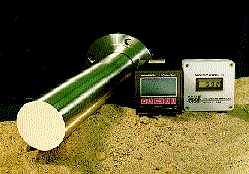 RadarTron was
created to accurately measure the moisture of fine aggregates such as
sand, crushed stone and other granular materials. Its microwave
technology eliminates all errors associated with resistance and
capacitance methods, guaranteeing an accurate reading every time.
RadarTron was
created to accurately measure the moisture of fine aggregates such as
sand, crushed stone and other granular materials. Its microwave
technology eliminates all errors associated with resistance and
capacitance methods, guaranteeing an accurate reading every time.
- RadarTron 1400C gives you consistent concrete yield, consistent colour/texture, consistent workability, consistent strength and consistent durability.
- RadarTron was the first sensor to have empty bin detection which holds the reading when material falls below the sensor, avoiding spoiled batches.
![]() Download brochure (355K)
Download brochure (355K)
Frequently Asked Questions on RadarTron View RadarTron slide show
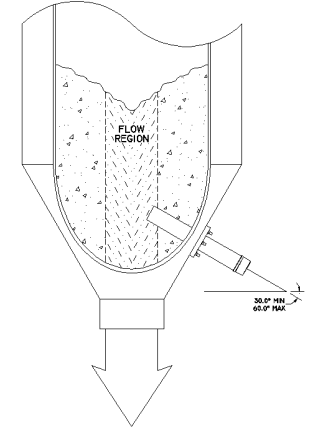 Easily installed in the bin wall, allowing insertion
into flow region above gate. Measurement must be made on the
material flowing out of the bin, not the stagnant material against the
bin wall. One-hole mounting allows installation in bin. Can be installed
in sand without emptying the bin. The
easiest sensor to install.
Easily installed in the bin wall, allowing insertion
into flow region above gate. Measurement must be made on the
material flowing out of the bin, not the stagnant material against the
bin wall. One-hole mounting allows installation in bin. Can be installed
in sand without emptying the bin. The
easiest sensor to install.
- The angle of the sensing head packs the flowing material precisely during the flow period so that measurement takes place on compacted material This is important in achieving the best accuracy.
- Flow averaging electronics gives an average reading over the flow period and holds this reading between batches, eliminating errors caused by dry or wet spots. It is essential to do these three things to get accurate results.
- Linear output does not require curve fitting techniques during calibration, guaranteeing good results.
- No separate electronics box is required; RadarTron is self-contained.
- Runs from mains power, 110/220 volts 50/60Hz. No separate power converter required
- Insensitive to temperature; does not require temperature compensation as do other sensors. More accurate as a result.
- One-step calibration using PC-compatible calibration disk. RadarTron is one step ahead; no other sensor is this easy to calibrate!
- Can be calibrated to read surface moisture or total moisture.
- Stainless steel body and ceramic faceplate for long wear free life; The ONLY sensor guaranteed 5 years for wear and 18 months for internal electronics.
- RadarTron model 1400C is 3.5" (89mm) diameter, 25" (635mm) long with 7.5" (190mm) diameter adjustable mounting flange. Moisture range is 0-20% on building sand. 110V or 220V power. Output is analog 0-10V, 0-5V or 4-20mA signal.
 Serial RS232/485 converters and PC input cards are
available. Optional digital display and graphic "Data Chart"
display unit for manual reading.
Serial RS232/485 converters and PC input cards are
available. Optional digital display and graphic "Data Chart"
display unit for manual reading.
- RadarTron has been proven accurate and reliable in hundreds of installations across North America, Europe and the Far East. We offer a free 30 day trial period in your plant. Alternatively, we can test a sample of "new to us" material to verify that it can be measured accurately. Consistently more accurate than the oven dry tests you use to check it.
- RadarTron is manufactured in North America, guaranteeing you fast service, repairs and parts. Our instruction manuals are in North American English; you can read and understand them easily.
- RadarTron is used by some of the largest concrete equipment manufacturers. Call or Email us for names.
RadarTron cost/payback analysis (.PDF file, 34K) RadarTron evaluation technique (31K)
Why do you need accurate moisture measurement? In concrete production, measurement of the moisture in the aggregate allows the proper weight of dry aggregate to be batched. If the sand contains 10% moisture, when 1000lb is weighed out, the scale contains only 900lb of sand; 100lb of the contents is water. If the moisture is known, 1100lb of sand is weighed out, giving 1000lb of sand and 100lb of water. The proportions of dry ingredients are corrected according to the mix design.
If the concrete has to meet NRMCA, NPCA or State requirements for accuracy of, say 2%, and the batch plant accuracy is 1.5%, the allowable error on moisture measurement is 0.5% in order to keep the total within 2%. It is impossible to meet these requirements by doing occasional oven dry or Speedy tests, even if one person is employed full time taking samples and running the tests. A moisture sensor allows the moisture to be sampled all the time and guarantees that the weights meet requirements on every batch, as well as saving the cost of manual testing.
It is impossible to guarantee that regulatory requirements are met without some form of automatic moisture measurement.
More background information - Concrete, water and moisture
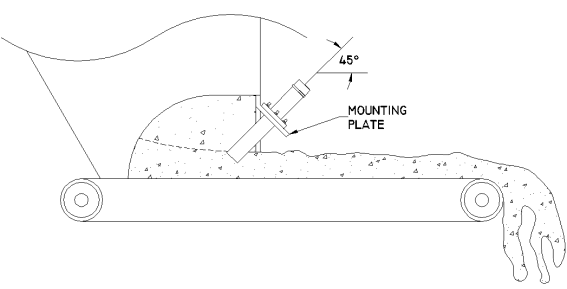 Other
applications: RadarTron can be
installed in vertical bins, horizontal bins, chutes and conveyor belts. In
horizontal bins with belt discharge, the sensor can be installed as shown
here. Mount it at a 45 degree angle and insert the faceplate into the flow
region just below the striking plate at the bin exit. This will allow it
to continue reading until the bin is completely empty.
Other
applications: RadarTron can be
installed in vertical bins, horizontal bins, chutes and conveyor belts. In
horizontal bins with belt discharge, the sensor can be installed as shown
here. Mount it at a 45 degree angle and insert the faceplate into the flow
region just below the striking plate at the bin exit. This will allow it
to continue reading until the bin is completely empty.
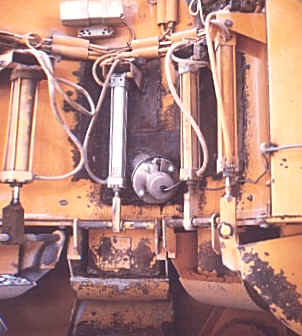 "Star" type plants - a difficult application
but by no means impossible: install RadarTron in the
bin wall as close to the gate as possible. Where mounting space is
insufficient for the standard mounting flange, use a 4" pipe welded to the
wall at an angle, with a standard ANSI flange welded to the end as the
mating connection for RadarTron's mounting flange. Ensure that you
angle it upward at 45 degrees and insert it far enough to clear the edge
of the skip when it raises.
"Star" type plants - a difficult application
but by no means impossible: install RadarTron in the
bin wall as close to the gate as possible. Where mounting space is
insufficient for the standard mounting flange, use a 4" pipe welded to the
wall at an angle, with a standard ANSI flange welded to the end as the
mating connection for RadarTron's mounting flange. Ensure that you
angle it upward at 45 degrees and insert it far enough to clear the edge
of the skip when it raises.
The illustration at left shows a good example of this type of installation in a Liebherr plant at Emirates Precast in Dubai; ideally the sensor should be angled steeper upwards than shown.
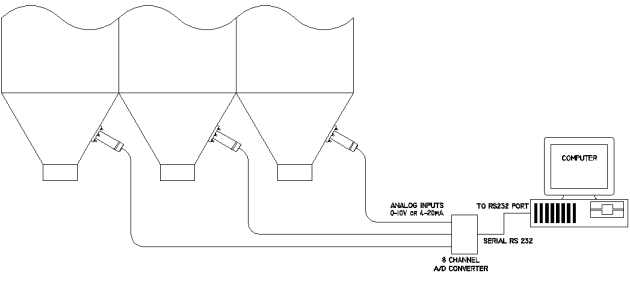
Several RadarTrons can be easily connected to a computer or PLC. The standard analog output can be fed into an analog input card which we provide for use in PC computers; 8 channels of analog inputs can be handled by one card.
Alternatively, the analog outputs from the sensors can be converted to digital data at low cost by use of a serial convertor. Both RS232 and RS485 types are available
.
Non-concrete applications: RadarTron is in use in many industries, concrete being the most common. Any granular material can be measured with the exception of metallic particles. Conductive materials such as carbon can be measured, as can most grains. As a rule of thumb, the smaller granule sizes will give better accuracy, 0.25" (6mm) and less giving more accuracy than the larger sizes. The moisture range depends on the bulk density of the material; in sand with bulk density of 100 to 150 lb/cu.ft, a moisture range of 0.5 to 15% can be measured accurately, the high end being limited only by saturation of the material. Lighter materials require a proportionately greater moisture range.
Before installing the RadarTron in a non-sand application, we usually test the material to ensure success. We need a sample of approximately 1 cu.ft. Call us to discuss your application.
Plastic pellets with moisture ranging from 0.01 to 0.1% cannot be measured with the RadarTron; its sensitivity is insufficient for this and similar applications. Call us if you are unsure, however.
Frequently Asked Questions on RadarTron
RadarTron
cost/payback analysis (.PDF file, 34K) RadarTron evaluation
technique (31K)
RadarTron users - download latest calibration software - Download